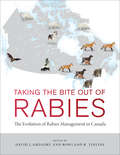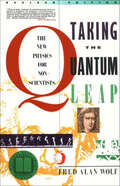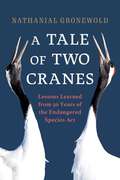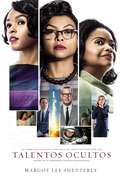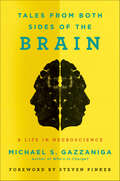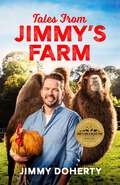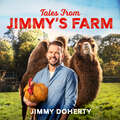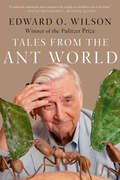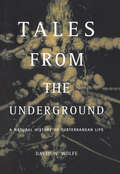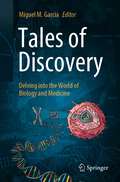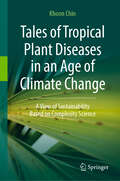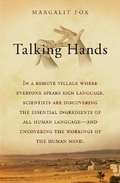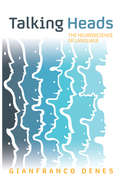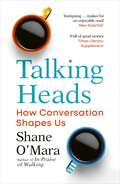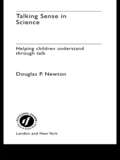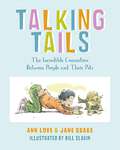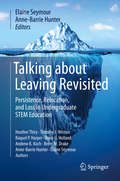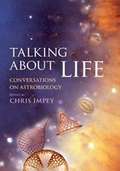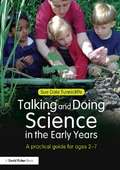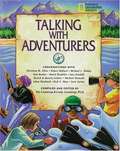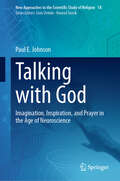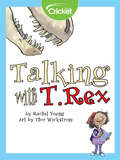- Table View
- List View
Taking the Bite Out of Rabies: The Evolution of Rabies Management in Canada
by David John Gregory Rowland TinlineInvolved in rabies research for much of their working careers, editors Rowland Tinline and David Gregory explore Canada’s unique contributions to rabies management in Taking the Bite out of Rabies. By placing the major players in rabies management from provincial and federal agencies, universities, and research institutions in historical context, Tinline and Gregory trace Canada’s largely successful efforts to control rabies. Concerned about the loss of institutional memory that tends to follow success, Tinline and Gregory view this book as a crucial way to collate, verify, and preserve records for future understanding and research. The book maps the history of rabies across Canada and explores the science, organization, research, and development behind Canada’s public health and wildlife vaccination programs. It also discusses how ongoing changes in agency mandates, the environment, and the evolution of the rabies virus affect present and future prevention and control efforts.
Taking the Quantum Leap: The New Physics for Nonscientists
by Fred A. WolfWorld renowned physicist Fred Alan Wolf explains the scientific concepts of quantum mechanics in accessible language for nonscientists.Winner of the National Book AwardTaking the Quantum Leap entertainingly traces the history of physics from the observations of the early Greeks through the discoveries of Galileo and Newton to the dazzling theories of such scientists as Planck, Einstein, Bohr, and Bohm. This humanized view of science opens up the mind-stretching visions of how quantum mechanics, God, human thought, and will are related, and provides profound implications for our understanding of the nature of reality and our relationship to the cosmos.“The prose, indeed, is exhilarating, and exhibits a passion to explain—humorously . . . Wolf provides commendable explanations of visions and revisions of atomic models; he is fin, in particular, on the Uncertainty Principle . . . Enjoy the book for its bravura.” —Kirkus Reviews
Tale of Two Cranes: Lessons Learned from 50 Years of the Endangered Species Act
by Nathanial GronewoldIt&’s been 50 years since the United States attempted a conservation revolution with the passing of the Endangered Species Act in 1973. Now, fifty years later, the Fish and Wildlife Service finds itself at a crossroads: some recovery efforts are succeeding, but too many are either failing or stuck in neutral, even after decades of work. Take, for example, the story of two cranes, the whoopingcrane of southeastern Texas and the red-crowned crane of northern Japan. Both were pushed to the brink of extinction by the early 1900s, with surviving populations numbering as few as 20 to 40 individuals, and are now the subjects of concerted recovery efforts led by advanced national governments. The U.S. Fish and Wildlife Service has focused mainly on habitat protection, while at Japan&’s Ministry of the Environment, conservation authorities have leaned most heavily on direct population survival via a long-standing winter feeding program. These two case studies provide a template for comparing different approaches towards endangered species: habitat management vs. population management. Thus far the Japanese approach has proved more successful, but the story isn&’t over yet. What can these lessons teach us about managing other endangered species? Can species rehabilitation be standardized, or must each effort be designed and implemented on a case-by-case basis? A Tale of Two Cranes will serve as a launching pad for better understanding the progress and pitfalls inherent in endangered species management, through 50 years of lessons learned since the landmark Endangered Species Act was enacted by the United States Congress in December 1973. Also considering its success stories like the Attwater&’s prairie chicken, the ESA has had an enormous impact on conservation theory and practice throughout the world, from Tasmanian devils in Australia to the vaquita porpoises of Mexico. But, worsening government budget constraints, public inattention, and a continuous string of setbacks experienced within numerous rehabilitation initiatives will all eventually conspire to challenge the conventional thinking on endangered species management like never before. Author Nathanial Gronewold explains how we got here, where things stand today, and what lessons conservationists must take to heart as the world continues to struggle to put a halt to an ongoing global extinction crisis.
Talentos ocultos: La genialidad no tiene color. La fuerza
by Margot Lee ShetterlyLa fenomenal historia de mujeres matemáticas afroamericanas de la NASA en la vanguardia del movimiento feminista y de derechos civiles, cuyos cálculos impulsaron uno de los mayores logros espaciales de Estados Unidos. Pronto será una gran película protagonizada por Taraji P. Henson, Octavia Spencer, Janelle Monae, Kirsten Dunst, y Kevin Costner. Antes de que John Glenn girara en órbita alrededor de la Tierra, o Neil Armstrong caminara en la luna, un grupo de mujeres profesionales en el área de las matemáticas conocidas como «computadoras humanas» usaron lápices, reglas de cálculo, máquinas de sumar para escribir las ecuaciones base para el lanzamiento de cohetes y astronautas al espacio. Entre ellas se encuentran un grupo de mujeres afroamericanas excepcionalmente talentosas, algunas de las mentes más brillantes de su generación. Originalmente relegadas a enseñar matemáticas en escuelas públicas segregadas del sur, fueron llamadas a servir durante la escasez laboral de la Segunda Guerra Mundial, cuando la industria aeronáutica de Estados Unidos se encontraba en extrema necesidad de alguien con conocimientos. Repentinamente, estas profesionales tenían acceso a un empleo digno de sus habilidades y respondieron al llamado del Tío Sam, se mudaron a Hampton, Virginia, y al fascinante mundo del Laboratorio Aeronáutico Langley Memorial. Iniciando en la Segunda Guerra Mundial y hasta la Guerra Fría, el Movimiento de los derechos civiles y la carrera espacial, Figuras ocultas entrelaza las historias de Dorothy Vaughan, Mary Jackson, Katherine Johnson y Christine Darden, cuatro mujeres afroamericanas que participaron en algunos de los mayores éxitos de la NASA. Es la crónica de sus carreras a lo largo de casi tres décadas en las que enfrentaron desafíos, alianzas y utilizaron su intelecto para cambiar sus vidas y el futuro de su
Tales Mummies Tell
by Patricia LauberThis book is all about mummies. They help us learn about ancient civilizations, whether they come from Egypt, Peru, China, or anywhere else in the world.
Tales from Both Sides of the Brain: A Life in Neuroscience
by Michael S. GazzanigaMichael S. Gazzaniga, one of the most important neuroscientists of the twentieth century, gives us an exciting behind-the-scenes look at his seminal work on that unlikely couple, the right and left brain. Foreword by Steven Pinker.In the mid-twentieth century, Michael S. Gazzaniga, “the father of cognitive neuroscience,” was part of a team of pioneering neuroscientists who developed the now foundational split-brain brain theory: the notion that the right and left hemispheres of the brain can act independently from one another and have different strengths.In Tales from Both Sides of the Brain, Gazzaniga tells the impassioned story of his life in science and his decades-long journey to understand how the separate spheres of our brains communicate and miscommunicate with their separate agendas. By turns humorous and moving, Tales from Both Sides of the Brain interweaves Gazzaniga’s scientific achievements with his reflections on the challenges and thrills of working as a scientist. In his engaging and accessible style, he paints a vivid portrait not only of his discovery of split-brain theory, but also of his comrades in arms—the many patients, friends, and family who have accompanied him on this wild ride of intellectual discovery.
Tales from Jimmy's Farm
by Jimmy DohertyThis year sees the 20th anniversary of Jimmy's Farm and Wildlife Park in Suffolk, which started out as a farm for rare breed pigs in 2002. This book will celebrate the journey that Jimmy and his family have found themselves on over the years, and the many animals that now call the farm home. 'Many seasons have passed since I came here but I can honestly say each one, emotionally - and on occasions physically! - has left its mark. To witness the changing of the seasons so closely, to understand how they shape both us and the natural world, will always be the ultimate reward.'In Tales From Jimmy's Farm, Jimmy Doherty reveals how he made his childhood dream of having his own wildlife park a reality - how, starting with a few rare breed pigs, he would transform a derelict and forgotten Suffolk farm into an A-Z of the animal world, from anteaters to zebras.Taking us on a journey through the seasons - spring lambs to rutting reindeer, sun-loving meerkats to festive monkeys - Jimmy reveals the ups and downs of a life immersed in the natural world, and explains how we too, wherever we may live, can benefit ourselves and the planet by embracing the remarkable animals around us.'Running a wildlife park is a complex job. To do it you need knowledge that varies from animal biology to how to get an ancient pink tractor running after a harsh frost. If there's a more diverse job, I'd like to hear about it. But the massive upside of all that hard work is simple. At all times you're embedded in the landscape and the lives of those incredible animals which depend on it - a beautiful natural gift which you are forever unwrapping.'As well as a whole host of other characters, Jimmy will introduce you to:*Teddy, Tip Tap and Tobias - a trio of tapirs*Alice and Arthur, the Mongolian Bactrian camels*Basil, the giant anteater*Dolph, Mistletoe and Rowan, the resident reindeers
Tales from Jimmy's Farm
by Jimmy DohertyThis year sees the 20th anniversary of Jimmy's Farm and Wildlife Park in Suffolk, which started out as a farm for rare breed pigs in 2002. This book will celebrate the journey that Jimmy and his family have found themselves on over the years, and the many animals that now call the farm home. 'Many seasons have passed since I came here but I can honestly say each one, emotionally - and on occasions physically! - has left its mark. To witness the changing of the seasons so closely, to understand how they shape both us and the natural world, will always be the ultimate reward.'In Tales From Jimmy's Farm, Jimmy Doherty reveals how he made his childhood dream of having his own wildlife park a reality - how, starting with a few rare breed pigs, he would transform a derelict and forgotten Suffolk farm into an A-Z of the animal world, from anteaters to zebras.Taking us on a journey through the seasons - spring lambs to rutting reindeer, sun-loving meerkats to festive monkeys - Jimmy reveals the ups and downs of a life immersed in the natural world, and explains how we too, wherever we may live, can benefit ourselves and the planet by embracing the remarkable animals around us.'Running a wildlife park is a complex job. To do it you need knowledge that varies from animal biology to how to get an ancient pink tractor running after a harsh frost. If there's a more diverse job, I'd like to hear about it. But the massive upside of all that hard work is simple. At all times you're embedded in the landscape and the lives of those incredible animals which depend on it - a beautiful natural gift which you are forever unwrapping.'As well as a whole host of other characters, Jimmy will introduce you to:*Teddy, Tip Tap and Tobias - a trio of tapirs*Alice and Arthur, the Mongolian Bactrian camels*Basil, the giant anteater*Dolph, Mistletoe and Rowan, the resident reindeers
Tales from Jimmy's Farm: A heartwarming celebration of nature, the changing seasons and a hugely popular wildlife park
by Jimmy DohertyAn insight into the life of a farmer-turned-zookeeper, following the ups and downs through the seasons with Jimmy and the animals at his wildlife park in Suffolk.Jimmy's Farm turns 20 years old in 2022. From starting out with rare breed pigs and a farm shop, Jimmy and his wife, Michaela, have grown the business over the years and the farm is now licensed to operate as a wildlife park.Tales From Jimmy's Farm follows a year in the life of the farm. The narrative traces the seasons as Jimmy documents what it means to live on a farm and what each day holds for him, his wife and four young daughters, the land he is farming and the animals in his care.The farm began life with rare breed pigs, but Jimmy soon expanded this to goats, cows, sheep and Suffolk Punch horses, too, and now the wildlife park plays host to over 80 species and breeds of traditional, rare and exotic animals, from crocodiles, camels and tapirs to skunks, wallabies and raccoons. Visitors can also learn about butterflies and insects in the Butterfly House, and meet reptiles and birds in the Tropical House. The listener will be transported into the landscape, learn of the practical day-to-day jobs, and fall in love with the animals through stories of where they came from, how they arrived and settled in, and funny anecdotes as Jimmy and his team got to know them. Along with a whole host of other characters, Jimmy will introduce you to:*Teddy and Tip Tap, a pair of tapirs*Alice and Arthur, the Mongolian Bactrian camels*Basil, the giant anteater*Dolph, Mistletoe and Rowan, the resident reindeers(P) 2022 Headline Publishing Group Ltd
Tales from the Ant World
by Edward O. WilsonEdward O. Wilson recalls his lifetime with ants, from his first boyhood encounters in the woods of Alabama to perilous journeys into the Brazilian rainforest. “Ants are the most warlike of all animals, with colony pitted against colony,” writes E.O. Wilson, one of the world’s most beloved scientists, “their clashes dwarf Waterloo and Gettysburg.” In Tales from the Ant World, two-time Pulitzer Prize-winner Wilson takes us on a myrmecological tour to such far-flung destinations as Mozambique and New Guinea, the Gulf of Mexico’s Dauphin Island and even his parent’s overgrown backyard, thrillingly relating his nine-decade-long scientific obsession with over 15,000 ant species. Animating his scientific observations with illuminating personal stories, Wilson hones in on twenty-five ant species to explain how these genetically superior creatures talk, smell, and taste, and more significantly, how they fight to determine who is dominant. Wryly observing that “males are little more than flying sperm missiles” or that ants send their “little old ladies into battle,” Wilson eloquently relays his brushes with fire, army, and leafcutter ants, as well as more exotic species. Among them are the very rare Matabele, Africa’s fiercest warrior ants, whose female hunters can carry up to fifteen termites in their jaw (and, as Wilson reports from personal experience, have an incredibly painful stinger); Costa Rica’s Basiceros, the slowest of all ants; and New Caledonia’s Bull Ants, the most endangered of them all, which Wilson discovered in 2011 after over twenty years of presumed extinction. Richly illustrated throughout with depictions of ant species by Kristen Orr, as well as photos from Wilsons’ expeditions throughout the world, Tales from the Ant World is a fascinating, if not occasionally hair-raising, personal account by one of our greatest scientists and a necessary volume for any lover of the natural world.
Tales from the Underground: A Natural History of Subterranean Life
by David W. WolfeThere are over one billion organisms in a pinch of soil, and many of them perform functions essential to all life on the planet. Yet we know much more about deep space than about the universe below. In Tales from the Underground, Cornell ecologist David W. Wolfe lifts the veil on this hidden world, revealing for the first time what makes subterranean life so unique and so precious. Home to miniscule water bears and microscopic bacteria, mole rats and burrowing owls, the underground reigns supreme as it produces important pharmaceuticals, recycles life's essential elements, and helps plants gather nutrients. An original, awe-inspiring journey through a strange realm, Tales from the Underground will forever alter our appreciation of the natural world around-and beneath-us.
Tales of Discovery: Delving into the World of Biology and Medicine
by Miguel M. GarciaResearch data sharing has traditionally been addressed to other peer researchers. Nowadays there is general awareness that putting research at the disposal of society is beneficial and necessary. However, the popularization of science is a hard endeavor. It must deal with transmission of transcendental knowledge with the appealing adornment of a good story, but avoiding the risk of falling into banality. This book consists in a series of individual stories delving into the world of biology and medicine. Some topics included in this volume consist in the explanation of basic biological concepts like the origin of modern eukaryotic cells, the importance of mutations as the driving force behind evolution, the molecular ins and outs of the nervous system, or the relevance of microorganisms to humans and science including food and energy industries. Others rather lean to a more biomedical perspective and constitute popular cases that have been, to some extent, trending in global media outlets: the divulgation of some current under-reckoned non-infectious pandemics like obesity and chronic pain, the presence of longer-living populations around the world named blue zones, the American (and African) opioid crisis, or the discovery and development of CRISPR-Cas as a promising genetic editing tool. All chapters are depicted with accompanying illustrations thoroughly elaborated by professionals of Fine Arts to make it easier to understand for the non-experts… but may perhaps also proof that the scientific method and multidisciplinary work are not unique to natural sciences, but also shared by other apparently distant disciplines like arts.
Tales of Tropical Plant Diseases in an Age of Climate Change: A View of Sustainability Based on Complexity Science
by Khoon ChinThis book offers a global perspective on major tropical crops, exploring their role in food production and the threats plant diseases pose to their productivity. Drawing from the author’s diverse experiences as a plant pathologist across Asia, Europe, the US, and Latin America, as well as his work as an independent research consultant on complexity science, the book offers both professional insights and personal reflections. Narratives have long been a powerful tool for human communication, often more knowledge-dense than any other form of exchange. The use of stories in this book serves three main purposes. First, complexity theory suggests that reflecting on others' stories can inspire scientists to form fresh perspectives and unique insights based on their own knowledge and experiences. This process may even help people "know what they didn’t know they knew," a concept popular in knowledge management circles. Complexity practice takes this further by helping scientists uncover what they "didn’t know they didn’t know"—a crucial element for advancing research rather than simply investigation. Second, today’s students often report learning more from the personal experiences of their teachers than from mere facts. Traditional, encyclopedic texts leave little room for the self-learning practices that are central to modern education. Stories, by contrast, are an effective way of conveying experiential or tacit knowledge, which is often more valuable in real-world contexts. Additionally, the use of narratives and visuals makes phytopathology more accessible for broader audience interested in sustainability, biodiversity, food security, biosecurity, regenerative agriculture, resilience, climate change, new technologies, and public policy. The final chapter ties the book together by focusing on sustainability and ecosystem services for the future. It also provides an extensively researched library of references on the management of tropical crop diseases, offering quick access to essential facts in the appendices.
Tales of a Dead King
by Walter Dean Myers2 teenagers uncover a plot to rob the tomb of an Egyptian pharaoh.
Talking Hands: What Sign Language Reveals About the Mind
by Margalit Fox<P>Imagine a village where everyone "speaks" sign language. Just such a village - an isolated Bedouin community in Israel with an unusually high rate of deafness - is at the heart of Talking Hands: What Sign Language Reveals About the Mind. There, an indigenous sign language has sprung up, used by deaf and hearing villagers alike. It is a language no outsider has been able to decode, until now. <P>A New York Times reporter trained as a linguist, Margalit Fox is the only Western journalist to have set foot in this remarkable village. In Talking Hands, she follows an international team of scientists that is unraveling this mysterious language. <P>Because the sign language of the village has arisen completely on its own, outside the influence of any other language, it is a living demonstration of the "language instinct," man's inborn capacity to create language. If the researchers can decode this language, they will have helped isolate ingredients essential to all human language, signed and spoken. But as Talking Hands grippingly shows, their work in the village is also a race against time, because the unique language of the village may already be endangered. <P>Talking Hands offers a fascinating introduction to the signed languages of the world- languages as beautiful, vital and emphatically human as any other- explaining why they are now furnishing cognitive scientists with long-sought keys to understanding how language works...
Talking Heads: The Neuroscience of Language
by Gianfranco DenesThe origin, development, and nature of language has been the focus of theoretical debate among philosophers for many centuries. Following the pioneering clinical observations 150 years ago of loss of language following a cerebral lesion, language started to be considered a biological system, that could be investigated scientifically. As a consequence, an increasing number of scientists began to search for its anatomical and functional basis and its links with other such cognitive systems. The relatively recent introduction of neuroimaging tools, such as PET and fMRI, has brought rapid and groundbreaking developments to the field of Neurolinguistics. In this book, Denes harnesses these advances to adopt a biolinguistic approach to the study of a subject that increasingly sees the collaboration of linguists, experimental psychologists, neuroscientists and clinicians. Talking Heads reviews the latest research to provide a concise analysis of the multifaceted aspects of language which focuses both on theoretical aspects and physical implementation. Following an up-to-date description of acquired language disorders, and their contribution to the design of a functional architecture of language, the book illustrates the neurological process involved in the production and comprehension of spoken and written language, as well as investigating the neurological and functional systems responsible for sign language production and first and second language acquisition. With a glossary of the anatomical and linguistic terms, this book provides an invaluable resource to undergraduate and graduate students of psychology, psycholinguistics and linguistics.
Talking Heads: The New Science of How Conversation Shapes Our Worlds
by Shane O'MaraFrom neurons to nations, Talking Heads is a stunning survey of the science of human connection and communication.'Delightfully well-written' IRISH TIMES'Intriguing ... Makes for an enjoyable read' NEW SCIENTIST'Full of good stories' TIMES LITERARY SUPPLEMENTTalking to each other is a primal behaviour. It’s a key part of what makes us human. Yet the science of human connection has largely remained a mystery. Only recently have scientific advances allowed us to peer into the purpose of conversations and uncover their extraordinary impact.In this groundbreaking book, the first of its kind written by a leading neuroscientist, Professor Shane O’Mara expertly reveals how talking affects all our lives. What does it mean that we mostly think, and speak, in five-minute bubbles around the present moment? Is the fact that we instinctively trust what others say empowering or a hindrance? And how do our very nations begin as conversations?Moving from the personal to the social and ultimately towards an urgent and radical new perspective on the defining phenomenon of our times, populist nationalism, Talking Heads is the story of how conversation shapes us and constructs our worlds – and how, together, we can talk our way into a better tomorrow.
Talking Sense in Science: Helping Children Understand Through Talk
by Douglas Newton Douglas P NewtonTalking Sense in Science is a highly practical guide to getting the most out of primary science lessons through talking with children. This clearly written and straightforward book helps teachers to support understanding by developing their own interaction in the classroom. Each idea is described, illustrated and followed by a short task to develop teaching skills. This book looks at ways of understanding in science, and scientific language as well as how talk can support practical activities. Douglas Newton also addresses the ideas of what to say, when to say it and how to say it, with a view to developing understanding through science conversation. Examples given in the book span the range of primary school science topics, and provide an ideal sourcebook for lesson ideas. Talking Sense in Science is an essential buy for primary teachers who want an accessible way to improve their practice and their pupils' understanding in science. It is also an ideal learning tool for student teachers.
Talking Tails: The Incredible Connection Between People and Their Pets
by Jane Drake Ann LovePets and their owners appear together in a book as heartwarming as it is informative.From our earliest beginnings, we have shared our lives with animals. Jane Drake and Ann Love explore the ties that humans and their pets have formed. With fun and fascinating facts, they address Dog People and Cat People. (Why does a cat wind around her owner's legs? She's rubbing her owner with glands on her face to say "you're mine.") They also introduce us to more unusual pets. There's Polly the parrot, who lived through the Klondike Gold Rush to be 126 years old by belting back whiskey, swearing, and biting gold miners. And, of course, there are fish and reptiles, rodents and horses, all of whom can be beloved pets. As useful as it is fun, Talking Tails is a must for children who have or want a pet.
Talking about Leaving Revisited: Persistence, Relocation, and Loss in Undergraduate STEM Education
by Heather Thiry Timothy J. Weston Raquel P. Harper Dana G. Holland Andrew K. Koch Brent M. DrakeTalking about Leaving Revisited discusses findings from a five-year study that explores the extent, nature, and contributory causes of field-switching both from and among “STEM” majors, and what enables persistence to graduation. The book reflects on what has and has not changed since publication of Talking about Leaving: Why Undergraduates Leave the Sciences (Elaine Seymour & Nancy M. Hewitt, Westview Press, 1997). With the editors’ guidance, the authors of each chapter collaborate to address key questions, drawing on findings from each related study source: national and institutional data, interviews with faculty and students, structured observations and student assessments of teaching methods in STEM gateway courses. Pitched to a wide audience, engaging in style, and richly illustrated in the interviewees’ own words, this book affords the most comprehensive explanatory account to date of persistence, relocation and loss in undergraduate sciences.Comprehensively addresses the causes of loss from undergraduate STEM majors—an issue of ongoing national concern.Presents critical research relevant for nationwide STEM education reform efforts.Explores the reasons why talented undergraduates abandon STEM majors.Dispels popular causal myths about why students choose to leave STEM majors.This volume is based upon work supported by the Alfred P. Sloan Foundation Award No. 2012-6-05 and the National Science Foundation Award No. DUE 1224637.
Talking about Life: Conversations on Astrobiology
by Chris ImpeyWith over 500 planets now known to exist beyond the Solar System, spacecraft heading for Mars, and the ongoing search for extraterrestrial intelligence, this timely book explores current ideas about the search for life in the Universe. It contains candid interviews with dozens of astronomers, geologists, biologists, and writers about the origin and range of terrestrial life and likely sites for life beyond Earth. The interviewees discuss what we've learnt from the missions to Mars and Titan, talk about the search for Earth clones, describe the surprising diversity of life on Earth, speculate about post-biological evolution, and explore what contact with intelligent aliens will mean to us. Covering topics from astronomy and planetary science to geology and biology, this book will fascinate anyone who has ever wondered 'Are we alone?'
Talking and Doing Science in the Early Years: A practical guide for ages 2-7
by Sue Dale TunnicliffeYoung children are intuitive, emergent scientists - they observe, raise hypotheses, experiment and notice patterns. Most of our everyday actions at home and in other settings, inside and outside, have a scientific basis and it is through these early experiences that children formulate their ideas about the world in which we live. This accessible book introduces the simplest form of the principles and the big ideas of science and provides a starting point for encouraging children to have an interest and experiential understanding of basic science and engineering. It shows you how you can support young children in exploring everyday phenomena and develop their scientific language skills through readily available resources and hands-on experiences. Each chapter focuses on a different aspect of science and includes: a summary of the ‘big ideas’ to refresh your own scientific knowledge; numerous activities that encourage young children to observe, question and carry out their own investigations; a usefil list of everyday resources and relevant vocabulary. Providing a wealth of exciting, meaningful ways to promote scientific experiences and learning, this highly practical book will help you to build on children’s natural curiosity about the world and develop their understanding through your everyday provision in early years settings and at home.
Talking with Adventurers
by Pat Cummings Linda CummingsAnswering questions such as "What was the scariest thing that ever happened in your work?", "What was the job that got you started in your field?", and "What is left for you to explore next?", 12 world-renowned adventurers present an inspiring picture of their lives and fascinating work.
Talking with God: Imagination, Inspiration, and Prayer in the Age of Neuroscience (New Approaches to the Scientific Study of Religion #18)
by Paul E. JohnsonTalking with God examines the neuroscience of belief and belief change related to prayer. It puts forward a model based on neuroscience and theology to understand how God speaks to us individually and inspires us through the human capacities for language and imagination. Offering a fresh, integrated perspective for those who struggle with the dissonance between their experience in the physical world and a healing spiritual life, this work navigates a path to reconcile religious spirituality with science. It also sheds light on an integrated view of science and religious belief, accepting the physicality of consciousness while allowing for spirituality in the form of divine inspiration. Talking with God is an original academic contribution to the field of science and religion and an indispensable read for researchers and readers interested in the concept of belief and belief change from a neuroscientific perspective.
Talking with T. Rex
by Rachel YoungA young girl meets a Tyrannosaurus rex at a museum and asks him—or her—some questions.
